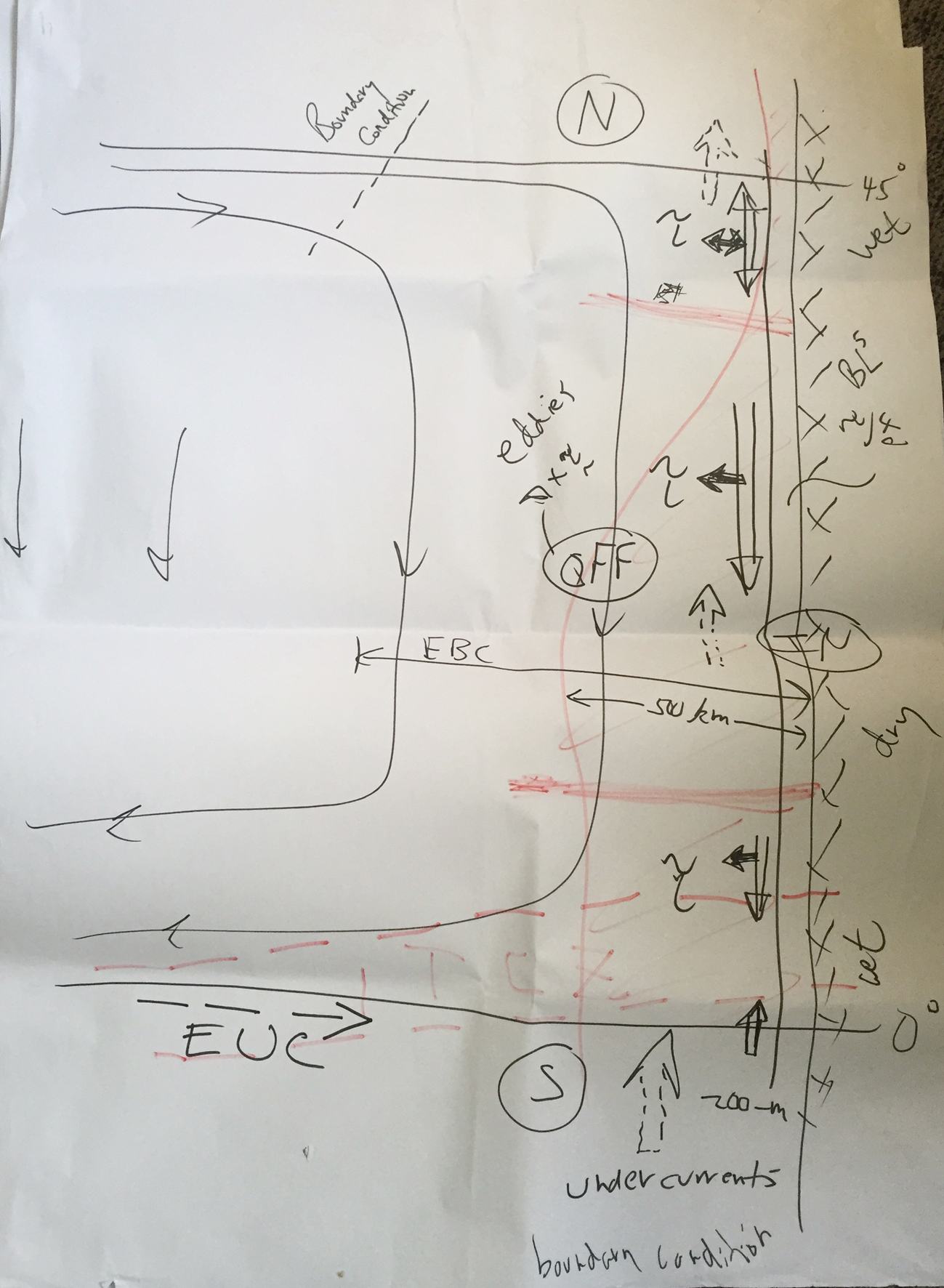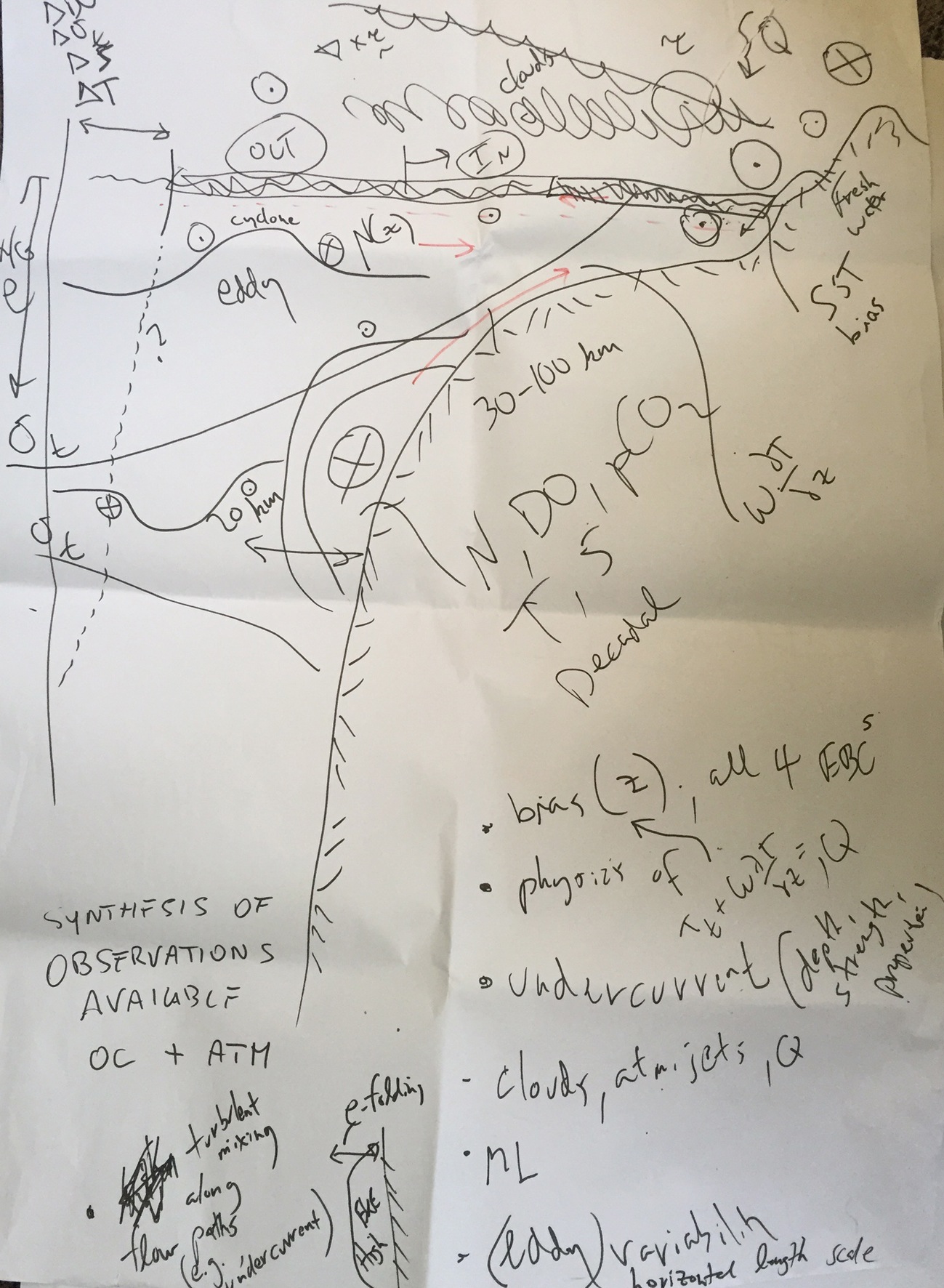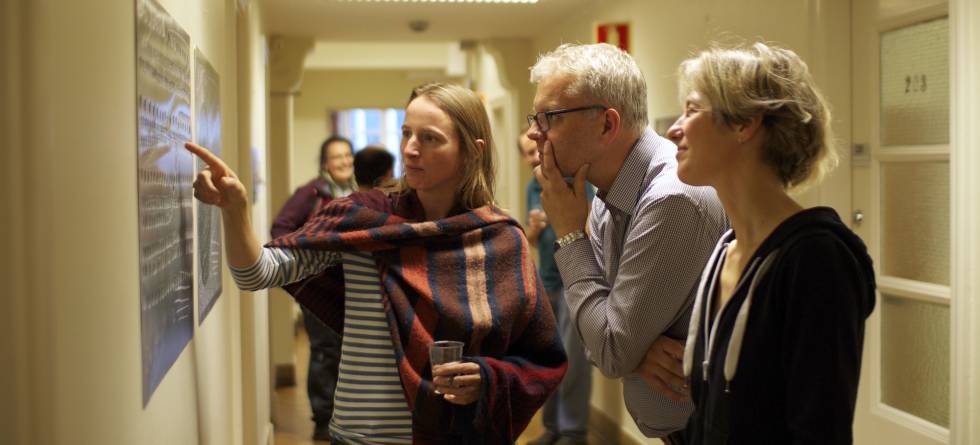Katrin von Lehmann tilbragte mars og april i 2014 på geofysisk institutt (GFI). I løpet av sju uker gjennomførte hun femten intervjuer med forskere om deres arbeid. Resultatet har blitt til utstillingen: Shifting – an intervention at the Geophysical Institute and the Bjerknes Centre for Climate Research.
Kunstneren ble overrasket over at forskerne valgte å fortelle om sitt arbeid gjennom illustrasjoner på vanlige tavler istedenfor å bruke digitale hjelpemidler som viser mer presise modeller. Det var disse illustrasjonene som ble utgangspunktet for hennes prosjekt og har resultert i fem serier med bilder kalt Blackboard Drawing #1 to #5.
Nye perspektiver
”I intervjuene prøvde jeg å forstå prosessene i atmosfæren og i havet, men jeg klarte ikke å forstå alt. Dette inspirerte meg til å arbeide videre med det som oppstår mellom det man forstår og det man ikke forstår”, forklarer Katrin von Lehmann.
Majoriteten av bildene i serien Blackboard Drawings består av to lag og for å skape en kobling mellom de to lagene brukte hun ulike perforasjonsteknikker. Hun forklarte hvordan hullene er med på å skape tilgang til fortiden samtidig som hullene tar vekk noe fra nåtiden.
Da folk beveget seg i korridoren på instituttet ble det åpenbart at det ikke bare var kunstneren som ønsker å forstå mer. Ulike diskusjoner oppsto rundt bildene og de fremmøtte var dypt konsentrert mens de prøvde å forstå systemene og reglene til Katrin von Lehmann. Samtidig som folk diskuterte mønstre var andre opptatt med å gjette seg frem til hvilke professorer som hadde tegnet illustrasjonene i serien Blackboard Drawings.
”Jeg oppdaget at assosiasjonene hver enkelt får til bildene er nært knyttet til deres forskningsfelt; en professor så luftbobler i havet og en annen så steiner og øyer. Vi ser det vi vet,” fortalte Katrin Katrin von Lehmann. Hun understrekte at hun ønsker å berike forskningen til forskerne ved å utfordre deres vitenskapelige perspektiver om hva de forstår og hva de ikke forstår.
Assosiasjoner fra forskerne selv
Association to series Blackboard Drawing 1
The different layers of the images remind me on a psychological principle of remembering and forgetting: Each time you remember something, you actually do not remember the experience itself but your latest memory of it. Each time you remember, you wipe out and replace the previous memory. Scientists may experience that they are sure to remember some facts just exactly as they are - but when they re-read/re-view the original they may realize that they forgot some details or that they may even remember something in a wrong way. So the layers of memories of a scientific fact are not exactly matching.
I interpret the holes in the images as my non-understanding of the science that is presented here. Also a phenomenon that students and scientists know very well: you listen to a scientific presentation, some parts you understand, some parts you don't understand. If there are only few holes, few details you did not understand, the whole picture may still be recognizable, which means you still get the message that the scientist meant to pass on. If there are too many holes, the story remains unclear to you.
Friederike Urbassek Hoffmann, October 2015
Association to series Blackboard Drawing
Jack stood up, fetched the paperboard standing in a corner of the conference room, and took a marker pen. “Let me try to make a drawing”, he said. We had been discussing for about an hour-and-a-half and tempers were starting to get frayed around this table. The ocean biologists were quietly conversing in their own splinter group, seemingly exchanging brief sentences and taking notes; they seemed to know what they were about, alright. Here, among the group of physical oceanographers and climate modellers sitting around this table, there was a sense of frustration. What are you not getting? Why do you keep intervening only to say the same thing again? Why do you stick to this obviously inadequate description of the problem? Why are you repeating this to me when I obviously already agreed with you – say it to the others!... Jack marked a rectangle on the paper sheet, and said: “this is our ocean”. Then he added some curved lines ending in an arrow, going around the boundary and extending inwards. “This is the large-scale flow”.

He added more arrows near the right-hand-side boundary, then circular symbols with a dot signifying arrows pointing out of the page - “the eastern boundary current, and upwelling”. More arrows for the winds, some squiggles for the Ekman drift and doodles for clouds, and Xs for land and terrain... a rough, poor drawing, hardly showing with any degree of accuracy the physical system we had tried so hard to describe to one another by words.
Yet, everybody became quiet and paid attention; even better, the mood palpably lifted. We knew what this was about. After a minute everyone was making suggestions, more words were added, a few equations to make quite sure; a second drawing giving a view from different angle (a section instead of a plan view) was quickly produced.

It took us a few minutes to agree on everything. Roles were parcelled out for the work to do, and we asked the biologists whether they had finished.
Thomas Toniazzo, October 2015

